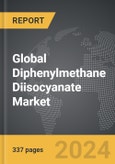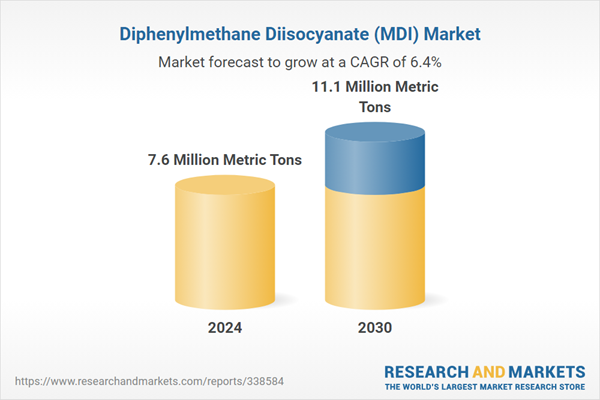The global market for Diphenylmethane Diisocyanate (MDI) was sized at 7.6 Million Metric Tons in 2024 and is projected to reach 11.1 Million Metric Tons by 2030, growing at a CAGR of 6.4% from 2024 to 2030. This comprehensive report provides an in-depth analysis of market trends, drivers, and forecasts, helping you make informed business decisions. The report includes the most recent global tariff developments and how they impact the Diphenylmethane Diisocyanate (MDI) market.
Segments: Application (Rigid Foams, CASE System, Flexible Foams, Other Applications); End-Use (Construction, Automotive, Furniture & Interiors, Electronics & Appliances, Footwear, Other End-Uses).
Geographic Regions/Countries: World; USA; Canada; Japan; China; Europe; France; Germany; Italy; UK; Spain; Russia; Rest of Europe; Asia-Pacific; Australia; India; South Korea; Rest of Asia-Pacific; Latin America; Argentina; Brazil; Mexico; Rest of Latin America; Middle East; Iran; Israel; Saudi Arabia; UAE; Rest of Middle East; Africa.
The analysts continuously track trade developments worldwide, drawing insights from leading global economists and over 200 industry and policy institutions, including think tanks, trade organizations, and national economic advisory bodies. This intelligence is integrated into forecasting models to provide timely, data-driven analysis of emerging risks and opportunities.
Global Diphenylmethane Diisocyanate (MDI) Market - Key Trends & Drivers Summarized
What Is Diphenylmethane Diisocyanate (MDI) and Why Is It Fundamental in Modern Manufacturing?
Diphenylmethane Diisocyanate (MDI) is one of the most important organic compounds used in the chemical industry today, fundamental due to its role in producing polyurethane products. As a versatile chemical building block, MDI reacts with polyols to form polyurethane, which is utilized in various applications ranging from rigid and flexible foams to elastomers and adhesives. Rigid polyurethane foams, where MDI is extensively used, are known for their excellent insulation properties, making them crucial in energy-efficient building constructions and the appliance industry. Additionally, the automotive sector relies on flexible polyurethane foams for comfort and safety in seating, headrests, and dashboard components. The broad application spectrum of MDI-based products underscores their importance across different sectors, highlighting the compound's integral role in enhancing product performance and energy efficiency.How Are Innovations and Regulations Shaping the MDI Industry?
The MDI industry is currently under significant transformation due to technological advancements and stringent environmental regulations. Innovation is primarily focused on enhancing the efficiency and safety of MDI production processes and developing new formulations that reduce the volatile organic compound (VOC) content in finished products. This is particularly crucial in the automotive and construction sectors, where regulatory pressures demand materials that contribute to safer and more sustainable environments. Moreover, advancements in catalyst technology and process engineering are enabling producers to manufacture MDI more efficiently and with a lower carbon footprint. Environmental regulations, particularly in Europe and North America, are also pushing for the development of MDI recycling technologies and alternative methods that can offer the same benefits as MDI but with an improved environmental profile. These shifts are not only driving innovation within the industry but are also reshaping market dynamics by influencing supply chains and production standards globally.What Challenges and Opportunities Exist in the MDI Market?
While MDI is invaluable in various applications, the market faces several challenges, primarily concerning health and environmental impacts. MDI is classified as a sensitizer and irritant, potentially hazardous when not handled under strict safety protocols. This has led to increased scrutiny from regulatory bodies, pushing companies to invest in safer handling practices and better protective equipment, which in turn increases operational costs. However, these challenges also present opportunities for innovation in product safety and sustainability. The industry is actively seeking ways to modify MDI formulations to reduce toxicity without compromising performance. Additionally, the rising demand for energy-efficient solutions offers substantial opportunities for MDI in the insulation sector, particularly in emerging markets where urbanization and industrialization are driving the demand for advanced construction materials.What Drives the Growth of the Diphenylmethane Diisocyanate (MDI) Market?
The growth in the diphenylmethane diisocyanate (MDI) market is driven by several factors, including the increasing demand for energy-efficient building solutions, advancements in automotive manufacturing techniques, and the rising need for high-performance adhesives and sealants. Energy efficiency initiatives worldwide have spurred the use of MDI in producing insulative materials, particularly in regions with stringent regulations concerning energy consumption in buildings. In the automotive sector, the push towards lighter and more fuel-efficient vehicles has heightened the demand for MDI-derived polyurethane foams that contribute to vehicle light-weighting while enhancing passenger safety and comfort. Additionally, the expanding electronics industry utilizes MDI-based products for various applications, including encapsulants and sealants, driven by consumer demand for more durable and compact devices. These technology-driven end-use requirements, along with evolving consumer behavior towards more sustainable products, play crucial roles in shaping the MDI market dynamics, ensuring its continued expansion and relevance in the global chemicals market.Report Scope
The report analyzes the Diphenylmethane Diisocyanate (MDI) market, presented in terms of units. The analysis covers the key segments and geographic regions outlined below.Segments: Application (Rigid Foams, CASE System, Flexible Foams, Other Applications); End-Use (Construction, Automotive, Furniture & Interiors, Electronics & Appliances, Footwear, Other End-Uses).
Geographic Regions/Countries: World; USA; Canada; Japan; China; Europe; France; Germany; Italy; UK; Spain; Russia; Rest of Europe; Asia-Pacific; Australia; India; South Korea; Rest of Asia-Pacific; Latin America; Argentina; Brazil; Mexico; Rest of Latin America; Middle East; Iran; Israel; Saudi Arabia; UAE; Rest of Middle East; Africa.
Key Insights:
- Market Growth: Understand the significant growth trajectory of the Rigid Foams segment, which is expected to reach 6.1 Million Metric Tons by 2030 with a CAGR of a 7.1%. The CASE System segment is also set to grow at 6.1% CAGR over the analysis period.
- Regional Analysis: Gain insights into the U.S. market, sized at 1.4 Million Metric Tons in 2024, and China, forecasted to grow at an impressive 7.2% CAGR to reach 3.5 Million Metric Tons by 2030. Discover growth trends in other key regions, including Japan, Canada, Germany, and the Asia-Pacific.
Why You Should Buy This Report:
- Detailed Market Analysis: Access a thorough analysis of the Global Diphenylmethane Diisocyanate (MDI) Market, covering all major geographic regions and market segments.
- Competitive Insights: Get an overview of the competitive landscape, including the market presence of major players across different geographies.
- Future Trends and Drivers: Understand the key trends and drivers shaping the future of the Global Diphenylmethane Diisocyanate (MDI) Market.
- Actionable Insights: Benefit from actionable insights that can help you identify new revenue opportunities and make strategic business decisions.
Key Questions Answered:
- How is the Global Diphenylmethane Diisocyanate (MDI) Market expected to evolve by 2030?
- What are the main drivers and restraints affecting the market?
- Which market segments will grow the most over the forecast period?
- How will market shares for different regions and segments change by 2030?
- Who are the leading players in the market, and what are their prospects?
Report Features:
- Comprehensive Market Data: Independent analysis of annual sales and market forecasts in US$ Million from 2024 to 2030.
- In-Depth Regional Analysis: Detailed insights into key markets, including the U.S., China, Japan, Canada, Europe, Asia-Pacific, Latin America, Middle East, and Africa.
- Company Profiles: Coverage of players such as Dow Inc., Merck KGaA, Mitsui Chemicals, Inc., Tosoh Corporation, Mitsui & Co., Ltd. and more.
- Complimentary Updates: Receive free report updates for one year to keep you informed of the latest market developments.
Some of the 21 companies featured in this Diphenylmethane Diisocyanate (MDI) market report include:
- Dow Inc.
- Merck KGaA
- Mitsui Chemicals, Inc.
- Tosoh Corporation
- Mitsui & Co., Ltd.
- Covestro AG
- Kumho Mitsui Chemicals Inc.
- Wanhua Chemical Group Co., Ltd.
Tariff Impact Analysis: Key Insights for 2025
Global tariff negotiations across 180+ countries are reshaping supply chains, costs, and competitiveness. This report reflects the latest developments as of April 2025 and incorporates forward-looking insights into the market outlook.The analysts continuously track trade developments worldwide, drawing insights from leading global economists and over 200 industry and policy institutions, including think tanks, trade organizations, and national economic advisory bodies. This intelligence is integrated into forecasting models to provide timely, data-driven analysis of emerging risks and opportunities.
What’s Included in This Edition:
- Tariff-adjusted market forecasts by region and segment
- Analysis of cost and supply chain implications by sourcing and trade exposure
- Strategic insights into geographic shifts
Buyers receive a free July 2025 update with:
- Finalized tariff impacts and new trade agreement effects
- Updated projections reflecting global sourcing and cost shifts
- Expanded country-specific coverage across the industry
Table of Contents
I. METHODOLOGYII. EXECUTIVE SUMMARY2. FOCUS ON SELECT PLAYERSIII. MARKET ANALYSISCANADAITALYSPAINRUSSIAREST OF EUROPEREST OF ASIA-PACIFICBRAZILMEXICOREST OF LATIN AMERICAREST OF WORLDIV. COMPETITION
1. MARKET OVERVIEW
3. MARKET TRENDS & DRIVERS
4. GLOBAL MARKET PERSPECTIVE
UNITED STATES
JAPAN
CHINA
EUROPE
FRANCE
GERMANY
UNITED KINGDOM
ASIA-PACIFIC
AUSTRALIA
INDIA
SOUTH KOREA
LATIN AMERICA
Companies Mentioned (Partial List)
A selection of companies mentioned in this report includes, but is not limited to:
- Dow Inc.
- Merck KGaA
- Mitsui Chemicals, Inc.
- Tosoh Corporation
- Mitsui & Co., Ltd.
- Covestro AG
- Kumho Mitsui Chemicals Inc.
- Wanhua Chemical Group Co., Ltd.
Table Information
| Report Attribute | Details |
|---|---|
| No. of Pages | 337 |
| Published | April 2025 |
| Forecast Period | 2024 - 2030 |
| Estimated Market Value in 2024 | 7.6 Million Metric Tons |
| Forecasted Market Value by 2030 | 11.1 Million Metric Tons |
| Compound Annual Growth Rate | 6.4% |
| Regions Covered | Global |









